Enfield
Explore hidden histories, historic photos, and things you never knew about Enfield from the collections and archives of Historic England.
Discover your local listed buildings and places
Introducing some of Enfield's most historic sites, included in the National Heritage List for England. Some of these captions have been summarised by AI. Click through for the official List entry. Skip this section and go to place by numbers
Elsyng Palace
Enfield
A multi-phase complex monument with medieval origins, later converted to an early Tudor courtier house belonging to Sir Thomas Lovell which was then taken over and adapted as a royal palace...
Grovelands Park
Enfield
Grovelands Park, originally designed by Humphry Repton and John Nash, evolved from private estate to public park, reflecting a rich history from 18th-century origins to 20th-century...
Parish Church of St John the Evangelist, Palmer's Green W…
Enfield
1903-4 E end including E part of the nave; completed 1907-8. Read the official list entry to find out more.
Oakwood Underground Station
Enfield
Underground railway station, 1933 by Charles Holden and Charles H James. Minor later alterations and addition of step-free access gantry in 2006-7.
Southgate Underground Station, Including Surface Building…
Enfield
Underground station with surface buildings and associated pylons and lamp posts.
Trent Park
Enfield
Trent Park evolved from an 18th-century hunting park into a significant estate developed by notable figures like Sir Richard Jebb and Sir Philip Sassoon. It later became Trent Country Park.
1 to 8 Station Parade, Including Eight Lamp Posts to East…
Enfield
The parade of shops were designed and built in 1932-33 to the designs of Charles Holden of Adams, Holden and Pearson for the London Passenger Transport Board.
Grovelands Park Hospital (Original Block Only)
Enfield
Grovelands Park Hospital, designed by John Nash in 1797, features a grand Ionic order with a 2-storey porch, ornate interiors, and classical scene decorations.
Flash Road aqueduct
Enfield
Flash Lane Aqueduct is part of the New River water supply, a significant 19th-century improvement in England. It showcases historical advancements in water provision and engineering.
Winchmore Hill Quaker Meeting House
Enfield
Quaker Meeting House. Built between 1790 and 1791 probably to designs by John Bevans of London.
Broomfield House
Enfield
Broomfield House and park, dating back to the 16th century, served various public functions but was damaged by fires in the late 20th century.
Arnos Grove Underground Station
Enfield
Underground railway station, 1932 by Charles Holden. Minor later alterations. Read the official list entry to find out more.
Moated site, Camlet Moat, Moat Wood
Enfield
Camlet Moat is a preserved medieval moated site near Parkside House, representing prestigious residences between 1250 and 1350.
Earthworks at Old Park
Enfield
The slight univallate hillfort near Grange Park Methodist Church is a rare and significant archaeological site from the Late Bronze to Early Iron Age in view of its well-preserved state and...
Church of St Alphege
Enfield
Church, 1959, by Sir Edward Maufe, with sculpture by Estcourt J Clack. Read the official list entry to find out more.
Forty Hall
Enfield
Forty Hall is a historic mansion built in the 17th century by Sir Nicholas Rainton, surrounded by landscaped gardens and parkland, now serving as a museum.
Church of St James
Enfield
1831 by W C Lochner, chancel added in 1864. Chancel rebuilt and internal modifications in 1969 by J Barrington Baker and Partners following a fire in 1967.
Myddelton House
Enfield
Myddelton House was developed into a renowned garden by E.A. Bowles, featuring diverse plant designs and specialty areas like the Rose Garden and Alpine Meadow.
Screen Wall, Gateway and North Pavilions to West of Forty…
Enfield
Circa 1630, the screen wall and pavilions feature a distinctive Dutch gable, brick cornice, and wrought iron gates, highlighting their architectural significance.
Cockfosters War Memorial
Enfield
First World War Memorial with later additions for the Second World War. Read the official list entry to find out more.
Edmonton War Memorial
Enfield
First World War memorial, designed by Louis Frederick Roslyn and unveiled on 26 October 1924, with Second World War additions. Read the official list entry to find out more.
Church of St Mary Magdalene
Enfield
1881-3 by William Butterfield. 1897-9 chancel embellishments by Charles Buckeridge, Edward Turner and N H J Westlake. 1907-8 Lady Chapel added. Read the official list entry to find out more.
Explore more
Search for more listed placesEnfield through time
This timeline shows the first period of use for buildings and places on the National Heritage List for England, just one of the details recorded for every list entry. Click around to see how Enfield changes over time. Skip this section and go to aerial photos
Prehistoric Before AD 43
Prehistory covers a million years of human occupation before the Roman invasion and the introduction of writing. Primarily hunter-gatherers of several human species including Neanderthals, the peoples moved across Europe, hunting animals, exchanging ideas and developing complex culture and belief systems including burial rites and astronomical understanding, as at Stonehenge for example.
Medieval AD 1066 to AD 1540
This period, sometimes known as the Middle Ages, began with the Norman invasion in AD 1066. It saw a significant rise in military and defensive buildings such as castles and earthworks, as well as religious houses dominating a largely agricultural landscape.
The monarchy and Church dominated the period, which also saw the break with the Roman Catholic Church and the English reformation.
Post medieval AD 1540 to AD 1901
The Post-Medieval period brought seismic changes to life in England, with religious reformation leading to the democratization of worship and the destruction of hundreds of religious houses.
In parallel, there was a huge expansion of scientific study and enlightenment that permanently altered the nation's social structure and landscape. Industrialization and mass production lead to wider global trade, emigration, and immigration.
20th century AD 1901 to AD 2000
The 20th century saw an incredible expansion of England's transport networks, with suburban growth shadowing rapid infrastructural expansion. The establishment of state schools, hospitals, and modern technical colleges, with new architectural styles, radically changed the appearance of towns and cities.
Two catastrophic world wars and the 1918 pandemic also brought unprecedented change, altering England's built environment and social structures forever.
Prehistoric Before AD 43
Prehistory covers a million years of human occupation before the Roman invasion and the introduction of writing. Primarily hunter-gatherers of several human species including Neanderthals, the peoples moved across Europe, hunting animals, exchanging ideas and developing complex culture and belief systems including burial rites and astronomical understanding, as at Stonehenge for example.
Medieval AD 1066 to AD 1540
This period, sometimes known as the Middle Ages, began with the Norman invasion in AD 1066. It saw a significant rise in military and defensive buildings such as castles and earthworks, as well as religious houses dominating a largely agricultural landscape.
The monarchy and Church dominated the period, which also saw the break with the Roman Catholic Church and the English reformation.
Post medieval AD 1540 to AD 1901
The Post-Medieval period brought seismic changes to life in England, with religious reformation leading to the democratization of worship and the destruction of hundreds of religious houses.
In parallel, there was a huge expansion of scientific study and enlightenment that permanently altered the nation's social structure and landscape. Industrialization and mass production lead to wider global trade, emigration, and immigration.
20th century AD 1901 to AD 2000
The 20th century saw an incredible expansion of England's transport networks, with suburban growth shadowing rapid infrastructural expansion. The establishment of state schools, hospitals, and modern technical colleges, with new architectural styles, radically changed the appearance of towns and cities.
Two catastrophic world wars and the 1918 pandemic also brought unprecedented change, altering England's built environment and social structures forever.
Aerial photos of Enfield
Aerial photography helps reveal secrets of England's changing landscapes that are impossible to see from the ground. Skip this section and go to archive images

Enfield Town
London Road and environs, Enfield Town, 1920
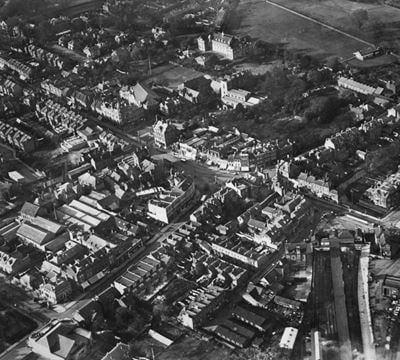
Enfield
London Road and the town centre, Enfield, 1928
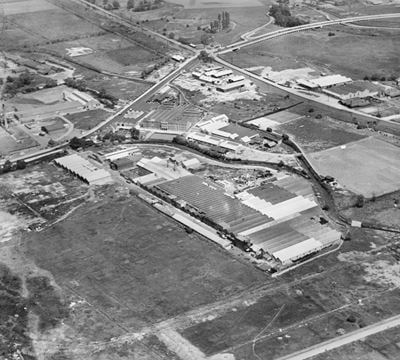
Edmonton
T. Glover and Co Gothic Gas Meter and Stove Works, Edmonton, 1930
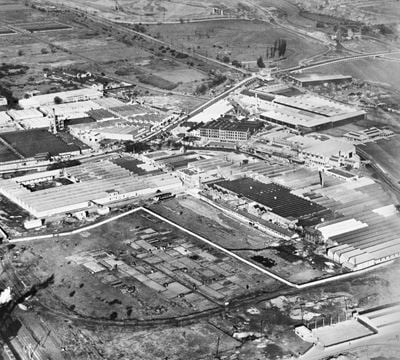
Edmonton
The Gothic Gas Meter and Stove Works and nearby factories off Angel Road, Edmonton, 1938

Upper Edmonton
The Gas Works, Upper Edmonton, 1923

Edmonton
Gas works adjacent to the Gothic Gas Meter and Stove Works, Edmonton, 1934
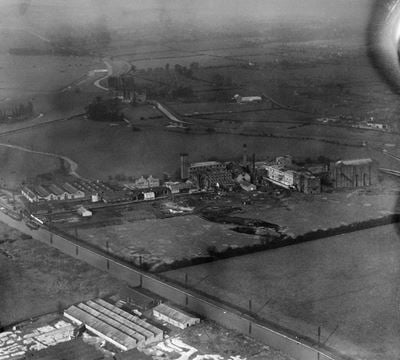
Edmonton
The Angel Road Linoleum Works, Edmonton, 1921

Edmonton
The Angel Factory Colony and the northern part of the Banbury Reservoir, Edmonton, 1937
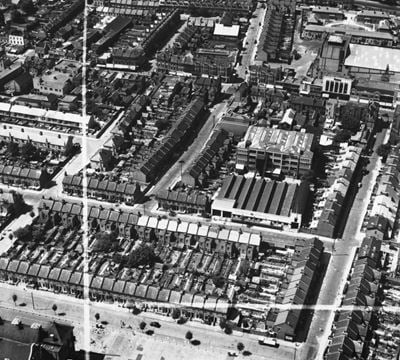
Upper Edmonton
The M.K. Electric Ltd Electrical Accessory Works off Wakefield Street and environs, Upper Edmonton, 1949
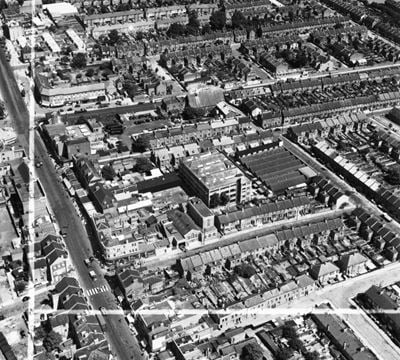
Upper Edmonton
Upper Fore Street and the M.K. Electric Ltd Electrical Accessory Works, Upper Edmonton, 1949
Enfield in the Historic England Archive
The Historic England Archive cares for over 15 million images, dating from the 1850s to the present day. Discover stunning images of Enfield's past. Skip this section and go to stories about heritage
John Gay Collection: Modern Architects
Islington, Greater London Authority
Date created: 1976 - 1979
A view of the living room in a flat, probably part of 53 to 131 Highbury Grove, a late twentieth century housing complex in Islington
John Laing Collection
Oakwood, Enfield, Greater London Authority
Date created: 1930s
View of the Laing housing estate at Enfield showing the estate office
Nigel Temple Collection of Postcards of Parks and Gardens
Pymmes Park, Enfield, Greater London Authority
Date created: 1904 - 1909
GENERAL VIEW SHOWING NEW LAKE
John Gay Collection: Modern Architects
Islington, Greater London Authority
Date created: 1976 - 1979
A view of the living room and kitchen in a flat, probably part of 53 to 131 Highbury Grove, a late twentieth century housing complex in Islington
John Laing Collection
Enfield, Greater London Authority
Date created: 08 Jun 1970
A group of men socialising during a golf party held at Hadley Wood Golf Club
Nigel Temple Collection of Postcards of Parks and Gardens
Pymmes Park, Enfield, Greater London Authority
Date created: 1904 - 1909
VIEW SHOWING THE OLD ENGLISH GARDEN
John Gay Collection: Modern Architects
Islington, Greater London Authority
Date created: 1976 - 1979
The interior of a living room in a flat, probably part of 53 to 131 Highbury Grove, a late twentieth century housing complex in Islington
John Laing Collection
Enfield, Greater London Authority
Date created: 15 Jun 1984
A prizegiving presentation taking place at a NSPCC sponsored golf day at Hadley Wood Golf Club
Nigel Temple Collection of Postcards of Parks and Gardens
Pymmes Park, Enfield, Greater London Authority
Date created: 1900 - 1950
GENERAL VIEW OF OLD ENGLISH GARDEN
John Gay Collection: Modern Architects
Islington, Greater London Authority
Date created: 1976 - 1979
The interior of a living room, which is probably part of 53 to 131 Highbury Grove, a late twentieth century complex in Islington
John Laing Collection
Enfield, Greater London Authority
Date created: 08 Jun 1970
A group of men playing a round of golf during a golf party at Hadley Wood Golf Club
Nigel Temple Collection of Postcards of Parks and Gardens
Pymmes Park, Enfield, Greater London Authority
Date created: 1900 - 1950
GENERAL VIEW OF PATH IN PARK
Stories about heritage in your local area
Historic England publishes news, blogs, research, videos, and podcasts celebrating England's rich heritage. Discover the stories we have about Enfield. Skip this section and go to education
English High Street Architecture Through the Ages
Mentions Barclays Bank, 20 The Town, Enfield
Explore how the architecture of the English high street has evolved over the centuries.
Amazing Architecture on the Underground
Mentions Southgate Underground Station, Including Surface Buildings and Platforms, Arnos Grove Underground Station
London Underground has a history of thoughtful and thorough design and detail
London Bank – Home to the World’s First Cash Machine – Listed
Mentions Barclays Bank, 20 The Town, Enfield, Enfield
The Barclays Bank in the London suburb of Enfield has been listed at Grade II.
War Memorials Listed Ahead of Armistice Day
Mentions Enfield
First World War memorials in England have been listed ahead of Armistice Day. Many of them also commemorate those lost during the Second World War.
New Research Reveals Legacy of State-Owned Pubs, Introduced to Prevent Excessive Drinking During the First World War
Mentions Enfield
The state-run “Carlisle Experiment” ran for 57 years (1916 - 1973), involving more than 400 public houses across Carlisle, Enfield and Cromarty Firth.
Heritage Across the Country Benefits from Latest Funding from the Culture Recovery Fund
Mentions Enfield
Over 470 heritage organisations across the country to benefit from the second round of Culture Recovery Fund grants
Enfield's social history through photos
Over 10,000 images from the Historic England Archive have been specially selected and re-captioned for teachers, students, and anyone who wants to learn more about their local area. Skip this section and go to grant-aided places
Wright's Almshouses, Hertford Road, Enfield, Greater London
Period: Victorian (1837 - 1901)
This row of almshouses were built in 1847.
Wright's Almshouses, Hertford Road, Enfield, Greater London
The School, Church Street, Enfield, Greater London
Period: Georgian (1714 - 1836)
This school was built in 1784. It has the inscription "A Structure of Hope, Founded in Faith and Based on Charity, 1784".
The School, Church Street, Enfield, Greater London
Ripaults Factory, Southbury Road, Enfield, Greater London
Period: 1930s (1930 - 1938)
This factory was built in c1930. It is built in an Art Deco style of architecture.
Ripaults Factory, Southbury Road, Enfield, Greater London
Palmers Green station, Enfield, London
Period: Edwardian (1902 - 1913)
Palmers Green station on the Great Northern Railway was opened in 1871 as a commuter station.
Palmers Green station, Enfield, London
Machine Shop at Royal Ordnance Factory, Ordnance Road, Enfield, Greater London
Period: Victorian (1837 - 1901)
This building was a small arms (hand guns) factory. It was built 1854-58 for the Board of Ordnance.
Machine Shop at Royal Ordnance Factory, Ordnance Road, Enfield, Greater London
Tags
Lamb's Cottage, Church Street, Edmonton, Greater London
Period: Stuart (1603 - 1713)
This cottage was built in the late 17th-early 18th century. It was home to Charles and Mary Lamb. Charles was born in London in 1775.
Lamb's Cottage, Church Street, Edmonton, Greater London
Bush Hill Sluice, Bush Hill Road, Enfield, Greater London
Period: Georgian (1714 - 1836)
This is a sluice house on the New River. It was built in 1796, probably by Robert Mylne, for the New River Company.
Bush Hill Sluice, Bush Hill Road, Enfield, Greater London
Arnos Grove Station, Bowes Road, Enfield, Greater London
Period: 1930s (1930 - 1938)
This station was built in 1932-4 by the architect Charles Holden.
Arnos Grove Station, Bowes Road, Enfield, Greater London
Discover more
Ready for more local heritage? Take a look at these other places nearby
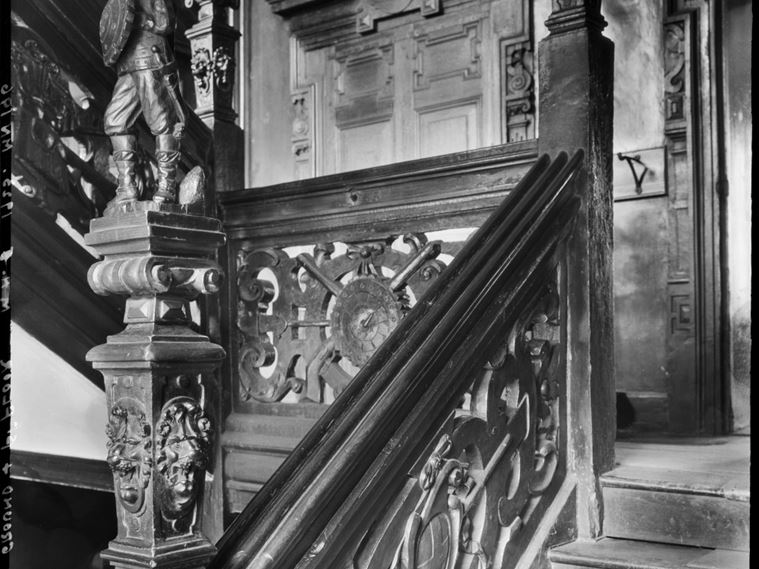
Haringey
Local Authority District

Waltham Forest
Local Authority District

Broxbourne
Local Authority District